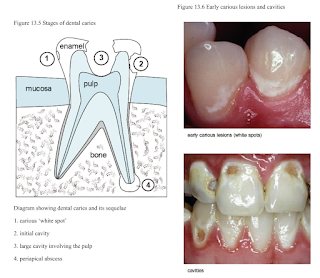Toothpaste
Introduction
Dental caries (tooth decay) is a pathological process resulting in localised destruction of tooth tissue.
- Dental plaque (a complex biofilm of mixed bacteria and their by-products) is a prerequisite for dental caries development.
- Frequent exposure to dietary sugar and carbohydrates leads to an increase in the population of cariogenic bacteria in the biofilm.
- Cariogenic bacteria produce organic acids, which lower the pH of the biofilm, resulting in enamel demineralisation (loss of carbonated hydroxyapatite).
NOTE: Dental caries can often progress without noticeable signs of deep or large cavities. To prevent further deterioration, it is advisable to consult a dentist as soon as you experience sensitivity to hot or cold temperatures, rather than waiting for more severe pain.
Fluoride-containing Toothpaste
Use of fluorides is the primary means of preventing dental caries across all age groups.
- Fluoride promotes enamel remineralisation through the formation of fluoride-containing apatites (e.g. fluorhydroxyapatite, fluorapatite), which are more resistant to future acid challenge than the carbonated hydroxyapatites of normal tooth enamel.
- Toothpastes that do not contain fluoride provide little protection against dental caries.
To minimise ingestion of fluoride, after brushing the teeth, toothpaste should be spat out and not swallowed.
- The mouth should not be rinsed to allow increased uptake of fluoride from the saliva.
Use in Infants and Young Children
However, excessive fluoride exposure in children can cause dental fluorosis, a mineralisation disorder of the teeth caused by excessive ingestion of fluoride during the tooth-forming years.
- In patients with dental fluorosis, the porosity of the subsurface enamel is increased and discolouration can occur (e.g. white spots, mottling).
UpToDate suggest that all children with teeth have their teeth brushed twice daily for two minutes with small amounts of fluoride-containing toothpaste.
- The appropriate amount of toothpaste for infants and toddlers (younger than 3 years) is a "smear" (a very thin layer of toothpaste that covers less than half of the bristle surface of a child-size toothbrush) or the size of a grain of rice.
- The amount of toothpaste should be increased to no more than a "pea-sized" amount at age 3 years; older preschoolers can use slightly more than a "pea-sized" amount.
Although ingesting more than a pea-sized amounts fluoride-containing toothpaste is associated with increased risk of fluorosis, most cases of fluorosis associated with fluoride toothpaste are mild and not considered unattractive.
NOTE: There is no clear consensus among paediatric and dental groups as to when use of fluoride toothpaste should be initiated.
Ingredients in Toothpaste
Fluoride
- The key ingredient to help prevent tooth decay.
- Examples: Sodium monofluorophosphate (MFP), sodium fluoride (NaF) and stannous fluoride (SnF2).
Surfactants
- Surfactants create foam during brushing, which helps spread the toothpaste in the mouth, break up dental plaque and loosen sticky food particles attached to the teeth.
- Examples: Sodium lauryl sulfate (SLS), cocamidopropyl betaine and sodium methyl cocoyl taurate (adinol)
- Physically remove stains from the surfaces of teeth.
- Examples: Calcium carbonate, calcium phosphate salts, alumina, silica and magnesium carbonate
Calculus (tartar) control
- Ingredients like pyrophosphates, zinc citrate and sodium hexametaphosphate can help reduce the build-up of calculus.
Teeth whitening
- Some toothpastes include sodium hexametaphosphate, which can repel stains from the surface of teeth.
- Hydrogen peroxide is added to toothpastes at levels from 1-5% to lighten the colour of teeth.
- Phthalimidoperoxycaproic acid (PAP) is an organic peroxide that acts like a bleaching agent for tooth whitening.
Tooth sensitivity
- Desensitizing toothpastes may include ingredients like potassium nitrate, arginine and calcium carbonate, strontium chloride, stannous fluoride, and calcium sodium phosphosilicate.
Thickening agents (binders)
- To achieve the desired paste consistency and prevent ingredients from separating.
- Examples: Mineral colloids, natural gums (e.g. xanthan gum), seaweed colloids (e.g. carrageenan) and synthetic cellulose.
- Help retain water within the toothpaste, preventing it from drying out.
- Examples: glycerol, propylene glycol and sorbitol.
Buffers
- Prevent acidity that could negatively affect the teeth.
- Examples: Trisodium phosphate, sodium citrate, sodium hydroxide and pyrophosphates.
Flavours
- Create breath-freshening benefits, such as menthol, spearmint or peppermint flavours.
- Balance the taste of the main flavour.
- Examples: Xylitol, sucralose and sodium saccharin.
Colour
- Ingredients like titanium dioxide make toothpaste appear white.
- Some toothpaste use food colours for a special appearance.
Summary
After brushing your teeth, it is best to spit out the toothpaste instead of rinsing with water.
- This allows the fluoride in the toothpaste to remain on your teeth for a longer period, helping to strengthen your enamel and prevent tooth decay.
External Links
- UpToDate - Preventive Dental Care and Counseling for Infants and Young Children
- Timing of fluoride intake in relation to development of fluorosis on maxillary central incisors, 2006
- Fluoride toothpaste efficacy and safety in children younger than 6 years: a systematic review, 2014
- Is there evidence for Novamin application in remineralization?: A Systematic review, 2020
- AAPD Fluoride Therapy, 2023
- RACGP Guidelines for Preventive Activities in General Practice, 2024
- EAPD Guidelines on the use of Fluoride for Caries Prevention in Children, 2019
- Fluoride toothpastes of different concentrations for preventing dental caries, 2019
- Fluoride Use in Caries Prevention in the Primary Care Setting, 2020
- Toothpaste ingredients, 2024


Comments
Post a Comment